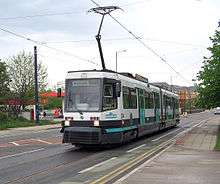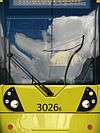T-68
| Ansaldo Firema T-68/T-68A | |
|---|---|
|
T-68 1011 in Manchester city centre in July 2008 | |
|
Interior of the prototype T-68 | |
| In service | 1992–2014 |
| Manufacturer | AnsaldoBreda |
| Built at | Naples, Italy |
| Family name | Firema |
| Constructed |
T-68: 1991–1992 T-68A: 1999 |
| Refurbishment |
2007–2010 midlife refurbishment, T-68 gain retractable couplers and covered bogies 2010–2012 reliability modifications, LCD screens, LED lights, driver's cab air conditioning |
| Number built |
T-68: 26 T-68A: 6 |
| Number in service | 0 |
| Number preserved | 6 |
| Formation | 2 carriages |
| Fleet numbers |
T-68: 1001-1026 T-68A: 2001-2006 |
| Capacity | 82/4 seats, 122 standing per vehicle |
| Operator(s) | Metrolink |
| Line(s) served | Altrincham, Bury, Eccles |
| Specifications | |
| Car body construction | Aluminium |
| Car length | 29 m (95 ft 2 in) |
| Width | 2.65 m (8 ft 8 in) |
| Height | 3.7 m (12 ft 2 in) |
| Articulated sections | 2 |
| Maximum speed | 50 mph (80 km/h) |
| Weight | 45 tonnes (44 long tons; 50 short tons) per vehicle |
| Traction motors |
T-68: 4x 105 kW (141 hp) separately excited DC motors T-68A: 4x 120 kW (160 hp) three–phase AC motors |
| Electric system(s) | 750 V DC OHLE |
| Current collection method |
Pantograph Type: Brecknell Willis High Reach |
| Track gauge | 1,435 mm (4 ft 8 1⁄2 in) standard gauge |
| Part of a series of articles on |
| Metrolink |
|---|
 |
The T-68 is a model of light rail passenger vehicle that operated on the Manchester Metrolink network in England between 1992 and 2014. It was part of the Firema range of vehicles, built specifically as a high-floor, articulated bi-directional tram to operate solely on the Manchester Metrolink system. The T-68s were constructed by the Italian manufacturer AnsaldoBreda at their factory in Naples Italy, entering service in 1992.[1]
The vehicles are atypical of vehicles used on light rail systems throughout the world, in that they are accessed by doors at a height of 0.9 metres (2 ft 11 in) from the ground, in order to be compatible with standard high-floor heavy railway platform, as were inherited by Metrolink.
Six modified variants of the T-68 (known as the T-68A) were added in 1999. In July 2012 it was announced by Transport for Greater Manchester that all T-68 and T-68A vehicles would be replaced by M5000s by 2014. The last T-68 was withdrawn on 26 May 2014.[2]
T-68
A single car prototype bodyshell numbered 1000 and given the name The Larry Sullivan was built in Italy in 1990 and delivered to Manchester for public exhibition to promote the system. It featured an orange and white Greater Manchester Passenger Transport Executive livery. It was later reliveried in the first Metrolink livery and it is now preserved and displayed at the Museum of Transport, Greater Manchester.
The first T-68s entered service on 6 April 1992. Initially 25 (1001-1025) were ordered, with a further one ordered to simplify scheduling problems. When the Eccles line opened three (1005, 1010 and 1015) were modified to run alongside the new T-68As. Later all bar 1018 - 1020 were similarly modified.
All the modified T-68s were designated T-68-M (Modified) but this designation was rarely used publicly. The modifications included retractable couplers, covered bogies, CCTV in place of mirrors and several other electronic modifications. All the T-68s were built with retractable steps; this is because Manchester's city stops were originally low height at the rear of the platform and passengers alighting from the rear unit of a double tram would need assistance from one of these steps. They were therefore only accessible from the rear tram of a double unit; since then, however, the city centre stops have been rebuilt, meaning that the only chance passengers had to use these steps was at Mosley Street, which closed in May 2013.
Vehicle 1007 had non standard seating with higher backs and more rounded grab handles. The tram was named East Lancashire Railway at a ceremony at Bury Interchange by Pete Waterman on 31 May 2009. The final three T-68s were withdrawn on 10 February 2014.[3] Another vehicle 1003 was later given the new Metrolink livery.
T-68A
The T-68As were introduced in 1999 for use on the Eccles Line. Six were built numbered 2001–2006. They were built with a version of all the modifications the T-68s received, so that they met all the requirements for street running on the Eccles line. After more T-68Ms entered service, the T-68As were seen on the other lines. The trams only ever operated as single units, this was due to a fault in the T-68As that prevent them from coupling to other units.
Vehicle 2001 was stored for several years as it developed a fault with the emergency brakes applying regularly without instruction to do so. The vehicle was completely rewired and brought back into service during 2011. The final two T-68As 2001 and 2003 were withdrawn on 30 April 2014.[3] 3 of them still reside on the scrap lines of Metrolink's Trafford Depot (unmodified) 1020, (modified) 1023 and (T68A) 2001.
Livery
The trams were liveried in a turquoise, white and grey livery.
Names
Twenty-three of the T-68s at some point had name plates, named after famous Mancunian people, achievements, places or company sponsorship.
- 1000 The Larry Sullivan (Prototype)[4]
- 1003 "Once Upon a Wartime" - Imperial War Museum North[5]
- 1004 Vans. The Original since 1966
- 1006 Vans. The Original since 1966
- 1007 East Lancashire Railway
- 1014 Vans. The Original since 1966
- 1020 Lancashire Fusilier
- 1022 The Poppy Appeal
- 1026 The Power
Withdrawal
The T-68/A fleet suffered poor reliability compared to the newer M5000 trams; the average distance between breakdowns was 5,000 miles, while the newer trams averaged 20,000 miles at introduction. In July 2012, Transport for Greater Manchester announced all of the T-68/T-68As would be replaced with M5000s.[6] The final three T68s were withdrawn on 10 February 2014 and the last two T-68As on 30 April 2014.[3]
To farewell the T-68s, on 26 May 2014 a farewell tour was operated by 1007 and 1016, the former being the first tram to run on the system when opened in 1992.[7]
One (1007) has been preserved at the Heaton Park Tramway.[8] One (1003) has been purchased as a training rig by Greater Manchester Fire and Rescue Service.[9] Four (1016, 1022, 1024 & 1026) have been transferred to the tram test centre at Long Marston.[10][11]
Gallery
.jpg) Prototype T-68 1000, at the Museum of Transport, Greater Manchester
Prototype T-68 1000, at the Museum of Transport, Greater Manchester T-68A tram no. 2004 in Eccles.
T-68A tram no. 2004 in Eccles. T-68 tram in Piccadilly Gardens.
T-68 tram in Piccadilly Gardens. Two T68s at the entrance to Victoria station.
Two T68s at the entrance to Victoria station..jpg) Driving position of T-68 tram.
Driving position of T-68 tram.
Media
In December 2010, a T-68 was used in the 50th anniversary live episode of the television programme Coronation Street, of the show to portray a tram crash on the street. As well as a mock-up tram for scenes after the crash, real life T-68 1015 was also used, given the fleet number 1030 (although this fleet number doesn't really exist) and temporary vinyl wrapped in the new livery.[12]
References
- ↑ "Metrolink Trams". TheTrams.co.uk. Retrieved 8 June 2008.
- ↑ "Historic day as Metrolink tram enthusiasts make final trip on the T68". Manchester Evening News. 26 May 2014. Retrieved 31 May 2014.
- 1 2 3 Manchester Metrolink British Trams Online
- ↑ http://www.flickr.com/photos/dwbphotos/5550473128/
- ↑ https://www.flickr.com/photos/47118s-pixs/6825235959/
- ↑ End of the line for Metrolink's first tram fleet Manchester Evening News 30 April 2014
- ↑ Special charity event will bid farewell to T68s Transport for Greater Manchester 14 May 2014
- ↑ Manchester Metrolink 1007 Heaton Park Tramway
- ↑ http://www.britishtramsonline.co.uk/news/?p=11016
- ↑ "UK moves to create tram test fleet" Tramways & Urban Transit issue 921 September 2014 page 360
- ↑ "Four Metrolink T68s moved to Long Marston". RAIL (758): 25. 1 October 2014. ISSN 0953-4563.
- ↑ "Coronation Street Tram Crash 6th December 2010 - Tram 1015 Burma Star (Marked up as tram 1030 on the show)". Flickr. Retrieved 20 September 2011.
External links
![]() Media related to Ansaldo Firema T-68 trams at Wikimedia Commons
Media related to Ansaldo Firema T-68 trams at Wikimedia Commons



